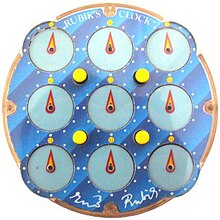|
Rubik's Clock The Rubik's Clock is a mechanical puzzle invented and patented by Christopher C. Wiggs and Christopher J. Taylor.[1] The Hungarian sculptor and professor of architecture Ernő Rubik bought the patent from them to market the product under his name. It was first marketed in 1988. The Rubik's Clock is a two-sided puzzle, each side presenting nine clocks to the puzzler. There are four dials, one at each corner of the puzzle, each allowing the corresponding corner clock to be rotated directly. (The corner clocks, unlike the other clocks, rotate on both sides of the puzzle simultaneously and can never be operated independently. Thus, the puzzle contains only 14 independent clocks.) There are also four pins which span both sides of the puzzle; each pin arranged such that if it is "in" on one side, it is "out" on the other. The state of each pin (in or out) determines whether the adjacent corner clock is mechanically connected to the three other adjacent clocks on the front side or on the back side: thus the configuration of the pins determines which sets of clocks can be turned simultaneously by rotating a suitable dial. The aim of the puzzle is to set all nine clocks to 12 o'clock (straight up) on both sides of the puzzle simultaneously. A method to do so is to start by constructing a cross on both sides (at 12 o’clock) and then solving the corner clocks individually. The Rubik's clock is listed as one of the 17 WCA events, with records for fastest time to solve one puzzle, and the fastest average time to solve 5 puzzles (discarding the slowest and fastest times). The puzzle is unique in the WCA in that it is the only puzzle for which viable speedsolving methods have been devised that always solve it in God's number moves (14 for the clock) or less; an example is "7-Simul", which involves performing seven pairs of moves on the front and back of the clock simultaneously and requires mental calculation from the puzzle's initial position to determine some moves. CombinationsSince there are 14 independent clocks, with 12 settings each, there are a total of =1,283,918,464,548,864 possible combinations for the clock faces. This does not count for the number of pin positions. NotationThe puzzle is oriented with 12 o'clock on top, and either side in front. The following moves can be made:[2] Pin movements
Wheel movements
Puzzle rotation
RecordsThe world record for single solve is held by Lachlan Gibson of New Zealand with a time of 1.86 seconds, set at A New Year in Auckland 2025. The world record for Olympic average of five solves is held by Volodymyr Kapustianskyi of Ukraine with an average of 2.39 seconds, set at Grand Forks 2024. Top 10 solvers by single solve[3]Top 12 solvers by Olympic average of 5 solves[4]References
External links
|
Portal di Ensiklopedia Dunia
